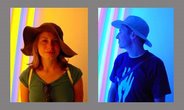Elroy Wolom
 9 x 9 x 9 x they say it's a hundred meters;
9 x 9 x 9 x they say it's a hundred meters;cotton yarn, Chinese ink, white glue; Reinhold Engberding; 2006
Last night we went to the opening of an exhibition of works by Reinhold Engberding, done during his stay here in Chiang Mai as part of a UNESCO grant. The exhibit, held in the diminutive "Yellow Room" (a side gallery off the main galleries, and source of the anagram tittling this post) of the Chiang Mai University Museum of Fine Art (a monsterous battleship of grey concrete with no permanent collection of its own), hosts two projects. One, entitled 9 x 9 x 9 x they say it's a hundred meters, consists of white fabric tubes, made from wrapped yarn, and graduated by one of Reinhold's personal measuring sticks--the length from his thumb to his forefinger. The marks were placed along the length of the yarn before it then was wrapped around trees of nine different species, and afterwards removed like a cast. Depending on the width of the trees, and regularity thereof, the marks created different patterns, ranging from helices, to scallops, to nearly random scatterings of dots. Accompanying the tubes are nine serigraphs of the leaves of each tree, done in white ink on unbleached saa paper, formated like botanical specimens, and labeled in Thai. Reinhold is a recovering landscape architect, much like I am a recovering gardener, and was pretty overwhelmed to find himself in an alien botanical context. Reaching out to the plants around him was an almost instinctual way of trying to orient himself in an unknown landscape. I find myself doing the same as I through our neighborhood, trying to come up with the genus, or at the very least the family, of the plants I see around me (Arum, Canna, Thalia dealbatana, Colocasia, Tectona grandis, Ficus religiosa, Agave americana, umm, umm, Bignoneaceae?)
The second project is of a series of interviews and reciprocal portraits done with Thai artists. Entitled How Are You?, the name is transliterated from a German idiomism (forgive me for latinizing, "idiomatic expression" is just so long) meaning, "What kind of person are you?" rather than, "How do you do?" Based on the questions asked, I would say that the real point of inquiry is actually, "How are you like me?" Several of the questions concerned the interviewee's knowledge of a foreign language (either English or Thai), their eating habits, their use of pseudonyms or nicknames, or the existence of an opposite gendered version of their name. All of these are of concern to Reinhold, either in his daily life in a foreign culture, or in his own artistic practice (see previous post). The artists then produced some sort of portrait of one another. Thailand seems to be the land of collaborative efforts, so it is interesting that Reinhold would choose here to take the step of enlisting other artists in the creation of his work, rather than just soliciting for material as he has done before in other community-based collaborations. Of course, this collaborative process, while no doubt rewarding, was also a source of frustration, as several artists failed to complete their interviews (in one of them only the first question was answered), or failed to complete their portraits. Though in the last case (that of a traditional woodcarver) the portrait in absentia inspired one of Reinhold's favorite text pieces, as yet untranslated into English, and perhaps untranslatable. That seems, at times, to be the boundary one walks as a foreign artist, the one between the untranslated and the untranslatable.



yo danish,
ReplyDeletethanks for the summary of reinholds final presentation, was slightly dissapointed i missed it. great photo of the caucasian raffi....
I think technically Raffi is caucasian, too, since his parents are Armenian. Though he was born in Cairo.
ReplyDeleteyou fastidious nutter, i suppose you're right. how is it that i've come to associate caucasian with poster children for the hitler youth?
ReplyDeletei'm blaming the jetlag....be good bro, see you guys in january